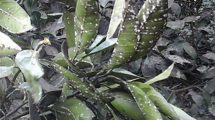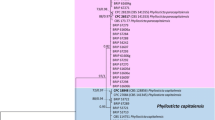Abstract
This study led to the discovery of four putative entomopathogenic fungi of armoured scale insects on citrus trees in coastal New South Wales. Two of these species belong in Podonectria as P. coccicola (Ellis & Everh.) Petch (syn. Tetracrium coccicola (Höhn.) Ellis & Everh.) and P. novae-zelandiae Dingley. Members of this genus are grown in culture for the first time. Formerly placed in the Pleosporales, Tubeufiaceae, or more recently in the Tubeufiales, these species are herein placed in the new family Podonectriaceae fam. nov., Pleosporales. Another species is placed in the Hypocreales, Bionectriaceae as Clonostachys coccicola (J.A. Stev.) H.T. Dao comb. nov. (basionym Tubercularia coccicola J.A. Stev., syn. Nectria tuberculariae Petch). The fourth species is Myriangium citri Henn. (Myriangiales, Myriangiaceae). Each fungal species is characterized and the phylogenetic placement confirmed by molecular analyses of the ITS and 28 s rDNA regions. In addition, their biology is noted, including location of the fungi within tree canopies.







Similar content being viewed by others
References
Bailey FM (1888) A Synopsis of the Queensland Flora. Second Supplement. James C. Beal, Government Printer, Brisbane, Australia
Barr ME (1980) On the family Tubeufiaceae (Pleosporales). Mycotaxon 7:137–167
Batista AC, da Silva MH (1957) Ontogênese de Myriangium citri P. Henn. Ann Soc Biol Pernambuco 15:355–360
Berkeley MJ (1845) Decades of fungi. Decades III–VII. Australian fungi. J Bot (London) 4:42–73
Boonmee S, Rossman AY, Liu J-K, Li W-J, Dai D-Q, Bhat JD, Gareth Jones EB, McKenzie EHC, Xu J-C, Hyde KD (2014) Tubeufiales, integrating sexual and asexual generic names. Fungal Divers 68:239–298
Burgess LW, Knight T, Tesoriero L, Phan HT (2008) Diagnostic manual for plant diseases in Vietnam. ACIAR Monograph 129. Australian Centre for International Agricultural Research, Canberra, Australia
Cooke MC (1887) New Australian fungi. Grevillea 16:1–6
Cooke MC (1892) Handbook of Australian fungi. Williams and Norgate, London
Corda ACJ (1839) Prachtflora Europaeischer Schimmelbildungen. Leipzig und Dresden, Germany
Dao TH (2012) Ecology of red scale (Aonidiella aurantii (Maskell) [Hemiptera: Sternorrhyncha: Diaspididae]) in citrus orchards on the Central Coast of New South Wales. PhD thesis, University of Western Sydney
Dao TH, Beattie GAC, Rossman AY, Burgess LW, Holford P (2015) Systematics and biology of two species of Microcera associated with armoured scales on citrus in Australia. Mycol Prog 14:17. doi:10.1007/s11557-015-1044-0
Dingley JM (1954) The Hypocreales of New Zealand. IV. The genera Hypocrella, Barya, Claviceps and Podonectria. Trans R Soc N Z 81:489–499
Dong J, Crane W, Crane JL (1998) Phylogenetic studies of the Leptosphaeriaceae, Pleosporaceae and some other Loculoascomycetes based on nuclear ribosomal DNA sequences. Mycol Res 102:151–156
Ellis JB, Everhart BM (1886) Nectria coccicola Ellis & Everh. J Mycol 2(4):3
Hely PC (1968) The entomology of citrus in New South Wales. Miscellaneous Publication 1. The Australian Entomological Society, Brisbane, Australia. 22 pp
Hennings AP (1908) Fungi S. Paulenses IV. Myriangiaceae. Hedwigia 1908:33
Hoffman M, Arnold AE (2008) Geography and host identity interact to shape communities of endophytic fungi in cupressaceous trees. Mycol Res 112:331–344
Höhnel FXR von (1911) Fragmente zur Mykologie (XIII. Mitteilung, Nr. 642 bis 718). Sitzungsberichte der Kaiserlichen Akademie der Wissenschaften in Wien, Mathematische-Naturwissenschaftliche Klasse, Abt. 1 120:379–484
Kimura M (1980) A simple method for estimating evolutionary rate of base substitutions through comparative studies of nucleotide sequences. J Mol Evol 16:111–120
Kirk PM, Cannon PF, David JC, Stalpers JA (2001) Ainsworth and Bisby’s dictionary of the fungi, 9th edn. CABI Publishing, Wallingford, United Kingdom
Kodsueb R, Dhanasekaran V, Aptroot A, Lumyong S, McKenzie EHC, Hyde KD, Jeewon R (2006a) The family Pleosporaceae: intergeneric relationships and phylogenetic perspectives based on sequence analyses of partial 28S rDNA. Mycologia 98:571–583
Kodsueb R, Jeewon R, Vijaykrishna D, McKenzie EHC, Lumyong P, Lumyong S, Hyde KD (2006b) Systematic revision of Tubeufiaceae based on morphological and molecular data. Fungal Divers 21:105–130
Koebele A (1892) Expert's trip to foreign countries. In: Report on the importation of parasites and predaceous insects by the State Board of Horticulture. A.J. Johnston, Superintendent State Printing, Sacramento, California, USA. pp 7–12. 1 pl
Koebele A (1893) Studies of parasitic and predaceous insects in New Zealand, Australia, and adjacent islands. United States Department of Agriculture. Government Printing Office, Washington, D.C., 39 pp
Marcelino JAP, Gouli S, Giordano R, Gouli VV, Parker BL, Skinner M (2007) Fungi associated with a natural epizootic in Fiorinia externa Ferris (Hemiptera: Diaspididae) populations. J Appl Entomol 133:82–89
McAlpine D (1896) The sooty mould fungi of citrus trees: a study in polymorphism. Appendix. Microcera coccophila Desm.—Coccus -loving Microcera. Proc Linn Soc N S W 21:498–499, 1 pl
McAlpine D (1899) Fungus diseases of citrus trees in Australia and their treatment. Melbourne: Robt. S. Brain, Government Printer, Melbourne, Australia
McNeill J, Barrie FF, Buck WR, Demoulin V, Greuter W, Hawksworth D L, Herendeen PS, Knapp S, Marhold K, Prado J, Prud’homme van Reine WF, Smith GF, Wiersema J, Turland NJ (eds.) (2012) International Code of Nomenclature for algae, fungi, and plants (Melbourne Code). [Regnum vegetabile no. 154.] Königstein: Koeltz Scientific Books
Miller JH (1940) The genus of Myriangium in North America. Mycologia 32:587–560
Petch T (1921a) Fungi parasitic on scale insects. Trans Br Mycol Soc 7:18–40
Petch T (1921b) Studies in entomogenous fungi. I. The Nectriae parasitic on scale insects. Trans Br Mycol Soc 7:89–167
Petch T (1924) Studies in entomogenous fungi. V. Myriangium. Trans Br Mycol Soc 10:45–80, Pls. 2–3. 1 fig
Rossman AY (1978) Podonectria, a genus in the Pleosporales on scale insects. Mycotaxon 7:163–182
Rossman AY (1987) The Tubeufiaceae and similar Loculoascomycetes. Mycol Pap (Wallingford) 157:1–89
Rossman AY, Seifert KA, Samuels GJ, Minnis AM, Schroers H-J, Lombard L, Crous PW, Põldmaa K, Cannon PF, Summerbell RC, Geiser DM, Zhuang W-Y, Hirooka Y, Herrera C, Salgado-Salazar C, Chaverri P (2013) Genera in Bionectriaceae, Hypocreaceae, and Nectriaceae (Hypocreales) proposed for acceptance or rejection. IMA Fungus 4:41–51
Rossman AY, Crous PW, Hyde KD, Hawksworth DL, Aptroot A, Bezerra JL, Bhat JD, Boehm E, Braun U, Boonmee S, Camporesi E, Chomnunti P, Dai D-Q, D'Souza MJ, Dissanayake AJ, Gareth Jones EB, Groenewald JZ, Hernandez-Restrepo M, Hongsanan S, Jaklitsch WM, Jayawardena R, Jing LW, Kirk PM, Lawrey JD, Mapook A, McKenzie EHC, Monkai J, Phillips AJL, Phookamsak R, Raja HA, Seifert KA, Senanayake I, Slippers B (2015) Recommended names of pleomorphic genera in Dothideomycetes. IMA Fungus 6(2):507–523
Schoch CL, Crous PW, Groenewald JZ, Boehm EW, Burgess TI, de Gruyter J, de Hoog GS, Dixon LJ, Grube M, Gueidan C, Harada Y, Hatakeyama S, Hirayama K, Hosoya T, Huhndorf SM, Hyde KD, Jones EB, Kohlmeyer J, Kruys A, Li YM, Lucking R, Lumbsch HT, Marvanova L, Mbatchou JS, McVay AH, Miller AN, Mugambi GK, Muggia L, Nelsen MP, Nelson P, Owensby CA, Phillips AJ, Phongpaichit S, Pointing SB, Pujade-Renaud V, Raja HA, Plata ER, Robbertse B, Ruibal C, Sakayaroj J, Sano T, Selbmann L, Shearer CA, Shirouzu T, Slippers B, Suetrong S, Tanaka K, Volkmann-Kohlmeyer B, Wingfield MJ, Wood AR, Woudenberg JH, Yonezawa H, Zhang Y, Spatafora JW (2009) A class-wide phylogenetic assessment of Dothideomycetes. Stud Mycol 64:1–15
Schroers H (2001) A monograph of Bionectria (Ascomycota, Hypocreales, Bionectriaceae) and its Clonostachys anamorphs. Stud Mycol 46:1–214
Stevenson JA (1917) Report of Department of Pathology and Botany. Porto Rico Insular Exp Sta Ann Rep 1916–17. pp. 37–98. http://hdl.handle.net/2027/uc1.b73821
Summerville WAT (1934) Queensland citrus scale insects and their control. Queensland Department of Agriculture and Stock, Division of Entomology and Plant Pathology, Bulletin 10. 101 pp
Tamura K, Stecher G, Peterson D, Filipski A, Kumar S (2013) MEGA6: Molecular Evolutionary Genetics Analysis version 6.0. Mol Biol Evol 30:2725–2729
Toledo AV, Virla E, Humber RA, Paradell SL, Lopez Lastra CC (2006) First record of Clonostachys rosea (Ascomycota: Hypocreales) as an entomopathogenic fungus of Oncometopia tucumana and Sonesimia grossa (Hemiptera: Cicadellidae) in Argentina. J Invertebr Pathol 92:7–10
Tryon H (1889) Report on Insect and Fungus Pests. James C. Beal, Government Printer Brisbane, Australia
Tryon H (1894) The disease affecting the orange orchards of Wide Bay, and the insect pests prevalent therein. Edmund Gregory, Government Printer, Brisbane, Australia
Vega FE, Meyling NV, Luangsa-ard JJ, Blackwell M (2012) Fungal entomopathogens. In: Vega FE, Kaya HK (eds) Insect pathology, 2nd edn. Academic Press, London
von Arx JA (1963) Die Gattungen der Myriangiales. Persoonia 2:421–475
Acknowledgments
The study was undertaken as part of postgraduate studies funded by an AusAID scholarship awarded to Dao Thi Hang. We thank the owners of study orchards on the Central Coast of New South Wales: Ted and Sylvia Lister, and Ross and Maureen Hitchcock at Kulnura, Max and Kevin Britten at Somersby, Jeromy Wallis and Gerry Whitmont at Lower Portland, Bruce and Phillip Gardiner at Cornwallis, and Deidre Hartog at Castlereagh. Ms Sandra Hardy (formerly Industry Leader Citrus, New South Wales Department of Primary Industries) is thanked for her enthusiastic support and interest. We thank Dr. Michael Priest, curator of the New South Wales Herbarium, Orange Agricultural Institute, Agriculture New South Wales) for identification of Myriangium citri and Dr. Silvio Lopes (Fundo de Defensa da Citricultura, Brazil) for his help with translation of some text on Myriangium citri from Portuguese to English.
Author information
Authors and Affiliations
Corresponding author
Additional information
Section Editor: Gerhard Rambold
Rights and permissions
About this article
Cite this article
Dao, H.T., Beattie, G.A.C., Rossman, A.Y. et al. Four putative entomopathogenic fungi of armoured scale insects on Citrus in Australia. Mycol Progress 15, 47 (2016). https://doi.org/10.1007/s11557-016-1188-6
Received:
Revised:
Accepted:
Published:
DOI: https://doi.org/10.1007/s11557-016-1188-6




